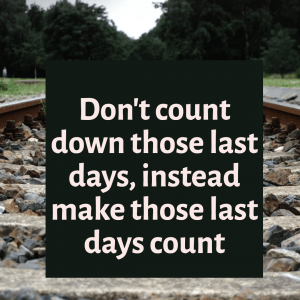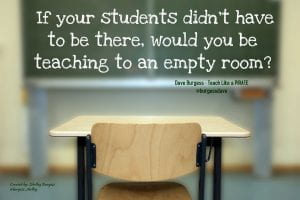When May rolls around, a recurring question pops up in many conversations that I have with non-educators and educators alike: “How many days left?” Of course, they are asking about how many days left until the school year ends, and the implication is that we/I can’t wait for that to happen. In the last several years, I have found a growing sense of irritation within myself when I hear this question. A recent blogpost from Pernille Ripp was the impetus for a reflection on the last 25 years of my own end-of-the-year countdowns. Her post is excellent, and well-worth the read: On Counting Down the Days…Again, May 19, 2021.

From Pernille Ripp’s May 19, 2021 blogpost
For the better half of my career, I sure did start counting down the days until the end of the school year. I often posted a countdown in my classroom and “celebrated” each day as we checked another day off. As we hit the last two weeks of school, it was common practice for me (and my colleagues) to start altering the normal routine: we strayed from our daily structure, and began inserting “fun” activities that were loosely connected to content from the school year: think “color by numbers,” time-filler worksheets, and writing end-of-the-year “reflections”. Each year, I found myself frustrated with escalating misbehaviors, a growing sense of dread as I thought about making it through each school day, and an overwhelming feeling of just wanting to be done.
Don’t get me wrong, misbehaviors do tend to escalate as the end of the year approaches, even without a change in routine. Many students are facing a summer filled with lack of structure, food insecurity, and possible abuse (we see lots of reminders about these students on social media at this time of year). As educators, don’t we have a responsibility to maintain a sense of normalcy for these kiddos? Some may argue that we owe it to the students to make things fun, in light of what they are facing, or that the students have already checked-out. Just last night, a friend said to me, “Aren’t the last five days of school just about babysitting, anyway?” If this is the case, perhaps we could benefit from spending some time reflecting on these two questions: 1) What role do I play in the mindset my students have? 2) Can we afford to give up one or two weeks of instruction? I know that we certainly cannot in our district, based on our reading and math proficiency rates. NAEP, the Nation’s Report card, tells us that we certainly cannot afford to as a nation, based on our national reading and math proficiency rates.
It wasn’t until a move to a new building in our district in 2013 that I started reflecting on the practice of counting down. OK, I didn’t reflect on it: I was forced into it. And I didn’t like it. The administrator of that building made it loud and clear that our expectation was to teach up until the last day of school. In fact, this expectation was first established around teaching up until the last minute of each class period. A simple time audit detailing time spent on instruction clearly outlines the “Why” behind these expectations. Instructional time is already at a premium each day, when we factor in time taken away for transitions alone, not to mention every other instructional time-sucker that exists in our daily school lives (lunch, preparation for going out to recess, coming in from recess, preparation for end of the day routines – filling out planners, getting ready for the bus, etc.). It didn’t take long for my initial dislike of my new administrator’s expectations to turn into an expectation that I loved, respected, and vow to never stray from.
I am not promoting a stance of “No fun in school.” I am promoting a clear, systematic, and explicit sequence of learning, each and every day. I am promoting a style of teaching, such as that described in Marzano’s The New Art and Science of Teaching, that instills a desire in our students to want to come to school each day. How do we get there? I can’t help but think of something I included in my March 28, 2021 post: “Tina Boogren, consultant for Solution Tree, reminds us about the importance of bringing enthusiasm and intensity to our daily work as educators. Boogren tells us that the word ‘enthusiasm’ can sound exhausting, if you think of it as being a cheerleader day in and day out. However, when you frame it around ensuring three things for your students, you have landed on its intention:
- Students know that you love your job.
- Students know that you love them.
- Students know that there is no place in the world you’d rather be. (ish!)”
Dave Burgess, amazing educator and author of Teach Like a Pirate, sums the idea up perfectly:

Some reflective questions we may want to ask ourselves include: 1) How am I structuring lessons so that my students want to be in my classroom, everyday? 2) How am I delivering lessons that are challenging and worthwhile? 3) How can I structure “Celebrations of Learning” days/class periods?
Speaking of those celebrations of learning, are we making sure they happen? There are opportunities to celebrate every day: when a student masters a new letter sound in kindergarten, when a fifth grader finishes a book, when a 7th grader completes a powerful argumentative essay, when a sophomore masters the art of using transition sentences. Are we celebrating the “small” successes, as well as the “big” successes? The EL Education curriculum builds in these bigger celebrations of learning at the end of each Module. Authors (Berger, Rugen, and Woodfin) of Leaders of Their Own Learning, explain their purpose this way: “Celebrations of learning are more than a display of student work and more than a party at the end of the year. The events compel students to reflect on and articulate what they have learned, how they learned, questions they answered, research they conducted, and areas of strength and struggles. They are powerful opportunities to make learning public.” If celebrations of learning aren’t already built into your curriculum, how can you build them in yourself?
As the school year draws to a close, there is a strong temptation (perhaps more prevalent in elementary than middle and high school) to dismantle our classrooms in those last few weeks. This temptation is the result of some of the following realities: logistically, we need to think through how we can stagger sending student work home. If we wait until the last day, our poor little charges won’t be able to take all of their work, plus belongings, home. In addition, if we steal some time during the school day when our students are still with us to begin this dismantling, it cuts down on the hours we would need to spend after school, outside of contract time, to make this happen. (Did anybody entering the field of education really think that their work would be limited to contract hours???) Again, I would put up the challenge to engage in some reflecting around this dismantling practice: 1) What message am I sending to my students when I begin dismantling their school “home” 10+ days before the last day of school? 2) How is beginning that dismantling practice early assisting in maintaining a routine centered around clear, systematic, and explicit teaching that results in high levels of learning? In other words, how is this beneficial to my students?
In addition to Pernille Ripp’s blogpost about counting down the days, perhaps I was spurred to write this post because I have been avoiding the countdown to the end of this school year as it has meant that our middle son, Owen, has come to the end of his school career. Yesterday, Owen William Kruse graduated from Fort Madison High School. He already spent the last week jumping into his future career as an electrician with Mohrfeld Electric, as a result of the strong support of teacher, mentor, and friend, Clint Kobelt. I am bursting-at-the-seams proud of Owen, but I miss the days of this little towhead depending on us for so much more than he does now!


Owen & Clint, August 2020

The Kruse Family: Owen’s graduation from Fort Madison High School, May 22, 2021